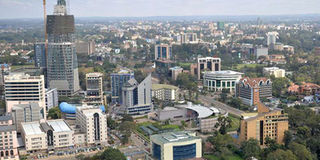Kenya’s top 10 richest counties

An aerial view of Nairobi. FILE PHOTO| NATION MEDIA GROUP
What you need to know:
- Nairobi, with a contribution of 21.7 percent to the overall GDP, is by far Kenya’s richest county, according to a new Kenya National Bureau of Statistics listing.
- The capital city is more than three-and-a-half times larger in economic terms than Nakuru, the second-richest county with a 6.1 percent share of the GDP.
- Kiambu (5.5 percent), Mombasa (4.7 percent) and Machakos (3.2 percent) complete the list of Kenya’s top five wealthiest counties in GDP terms.
Nairobi, Nakuru and Kiambu are Kenya’s top-three richest counties while Lamu, Samburu and Isiolo are the poorest, according to a new report ranking the contribution of Kenya’s 47 regions to the national annual economic output, also known as the Gross Domestic Product (GDP).
Nairobi, with a contribution of 21.7 percent to the overall GDP, is by far Kenya’s richest county, according to a new Kenya National Bureau of Statistics listing released Wednesday. T
he capital city is more than three-and-a-half times larger in economic terms than Nakuru, the second-richest county with a 6.1 percent share of the GDP. Kiambu (5.5 percent), Mombasa (4.7 percent) and Machakos (3.2 percent) complete the list of Kenya’s top five wealthiest counties in GDP terms.
NEW STUDY
The rest of the top ten counties are Meru (2.9 percent), Kisumu (2.9 percent), Nyandarua (2.6 percent), Kakamega (2.4 percent) and Uasin-Gishu (2.3 percent).
The first ever comprehensive study by KNBS of counties’ wealth provides a measure of how much each region contributed to the national cake as at the end of 2017.“Nairobi seized the lion’s share of Kenya GDP at 21.7 percent,” said KNBS director-general Zachary Mwangi during the report’s release in the capital yesterday.
The report titled Gross County Product (GCP) 2019 was funded by the World Bank. It tracked the monetary measure of the market value of all the final goods and services produced in each of the 47 counties, with a view to providing a picture of the economic structure and relative size of the economy for each county.
KNBS describes the Gross County Product (GCP) as the net value of goods and services produced within the boundaries of a specific county. It is the equivalent of the county GDP. Nairobi’s contribution to the national wealth dispels the notion that the seat of power accounts for more than 60 percent of national output as previously widely held.
ECONOMIC ACTIVITIES
According to the study, the dominant counties are associated with large populations in urban centres. In addition, the counties are backed by thriving economic activities such as agriculture, manufacturing, transportation, financial and real estate as well as wholesale and retail trade.
The study says that agriculture, which is Kenya’s economic backbone, remains a key driver of growth in most counties with the exception of Nairobi and Mombasa. It helped counties such as Nakuru, Kiambu, Meru, Bungoma, Kakamega and Nyeri to record robust growth powered by agriculture and the services sectors.
“The latest data was drawn from regular data collected by the agency through recurrent and intermittent surveys and censuses and administrative records,” said KNBS. A survey was also conducted in all 47 counties in 2018 to supplement the existing data sets. The counties that contribute the least to national wealth, according to the report, are Isiolo at 0.2 percent and Samburu at 0.3 percent. The others are Lamu (0.4 percent), Marsabit (0.5 percent), Tana River (0.5 percent), Mandera (0.5 percent), Wajir (0.5 percent), Garissa (0.6 percent), West Pokot (0.7 percent) and Taita Taveta (0.5 percent).
REVENUE
In providing the wealth estimates generated by each county, the Chairperson of the Commission on Revenue Allocation (CRA), Ms Jane Kiringai, said the study had identified the missing piece of the jigsaw puzzle that is revenue sharing. “The report is expected to help shape the revenue sharing debate,” she said.
CRA has already proposed a formula for sharing of revenue among the 47 counties that will be influenced less by levels of poverty and population of a devolved unit. Treasury Cabinet Secretary Henry Rotich urged investors and county administrators to exploit the latest data to make investment decisions.
He said that the estimates are expected to be instrumental in supporting county level decision-making and economic planning. “The intention of the report is to promote evidence-based economic planning, programming and policymaking in Kenya,” said Mr Rotich in a speech read on his behalf by Treasury chief administrative secretary Nelson Gaichuhie.
Reacting to the report’s findings, Nakuru Governor Lee Kinyanjui said the county would maximise the county’s potential by tapping into agriculture and tourism. “A team of economists and experts are currently working on a draft integrated economic plan for the next ten years. This will be a blueprint to guide development for the next decade,” said Mr Kinyanjui.
The Kiambu County executive in charge of finance and economic planning, Mr Francis Kigo Njenga, welcomed the report’s findings.





